This article needs additional citations for verification .(March 2016) |

Sh is a digraph of the Latin alphabet, a combination of S and H.
This article needs additional citations for verification .(March 2016) |

Sh is a digraph of the Latin alphabet, a combination of S and H.
In Albanian, sh represents [ ʃ ]. It is considered a distinct letter, named shë, and placed between S and T in the Albanian alphabet.
In Breton, sh represents [ s ]. It is not considered a distinct letter and it is a variety of zh (e. g. koshoc'h ("older"). It is not considered as a digraph in compound words, such as kroashent ("roundabout": kroaz ("cross") + hent ("way", "ford").
In English, ⟨sh⟩ usually represents /ʃ/. The exception is in compound words, where the ⟨s⟩ and ⟨h⟩ are not a digraph, but pronounced separately, e.g. hogshead is hogs-head/ˈhɒɡz.hɛd/, not *hog-shead/ˈhɒɡ.ʃɛd/. Sh is not considered a distinct letter for collation purposes.
![]() American Literary braille includes a single-cell contraction for the digraph with the dot pattern (1 4 6). In isolation it stands for the word "shall".
American Literary braille includes a single-cell contraction for the digraph with the dot pattern (1 4 6). In isolation it stands for the word "shall".
In Old English orthography, the sound /ʃ/ was written ⟨sc⟩. In Middle English it came to be written ⟨sch⟩ or ⟨sh⟩; the latter spelling has been adopted as the usual one in Modern English.
In Irish, ⟨sh⟩ represents [h] and marks the lenition of ⟨s⟩; for example mo shaol[mˠəhiːlˠ] "my life" (cf. saol[sˠiːlˠ] "life").
In Judaeo-Spanish, sh represents [ ʃ ] and occurs in both native words (debasho, ‘under’) and foreign ones (shalom, ‘hello’). In the Hebrew script it is written ש.
In Occitan, sh represents [ ʃ ]. It mostly occurs in the Gascon dialect of Occitan and corresponds with s or ss in other Occitan dialects: peish = peis "fish", naishença = naissença "birth", sheis = sièis "six". An i before sh is silent: peish, naishença are pronounced [ˈpeʃ,naˈʃensɔ]. Some words have sh in all Occitan dialects: they are Gascon words adopted in all the Occitan language (Aush "Auch", Arcaishon "Arcachon") or foreign borrowings (shampó "shampoo").
For s·h, see Interpunct#Occitan.
In Spanish, sh represents [ ʃ ] almost only in foreign origin words, as flash, show, shuara or geisha. Royal Spanish Academy recommends adapting in both spelling and pronunciation with s, adapting to common pronunciation in peninsular dialect. Nevertheless, in American dialects it is frequently pronounced [ t͡ʃ]. [1]
Sh represents the sound [ ʃ ] in the Somali Latin Alphabet. [2] It is considered a separate letter, and is the 9th letter of the alphabet.
Sh represents the sound [ ʃ ] in the Uyghur Latin script. It is considered a separate letter, and is the 14th letter of the alphabet.
In Uzbek, the letter sh represents [ ʃ ]. It is the 27th letter of the Uzbek alphabet.
In Finnish and Estonian, sh is used in place of š to represent [ ʃ] when the accented character is unavailable.
In the Pinyin, Wade-Giles, and Yale romanizations of Chinese, sh represents retroflex [ ʂ ]. It contrasts with [ ɕ ], which is written x in Pinyin, hs in Wade-Giles, and sy in Yale.
In the Hepburn romanization of Japanese, sh represents [ ɕ ]. Other romanizations write [ɕ] as s before i and sy before other vowels.

A diacritic is a glyph added to a letter or to a basic glyph. The term derives from the Ancient Greek διακριτικός, from διακρίνω. The word diacritic is a noun, though it is sometimes used in an attributive sense, whereas diacritical is only an adjective. Some diacritics, such as the acute ⟨á⟩, grave ⟨à⟩, and circumflex ⟨â⟩, are often called accents. Diacritics may appear above or below a letter or in some other position such as within the letter or between two letters.
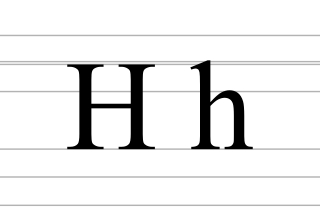
H, or h, is the eighth letter of the Latin alphabet, used in the modern English alphabet, including the alphabets of other western European languages and others worldwide. Its name in English is aitch, or regionally haitch.
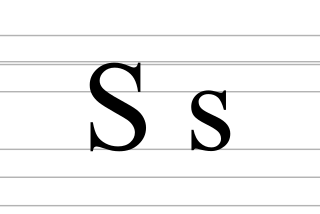
S, or s, is the nineteenth letter of the Latin alphabet, used in the modern English alphabet, the alphabets of other western European languages and others worldwide. Its name in English is ess, plural esses.
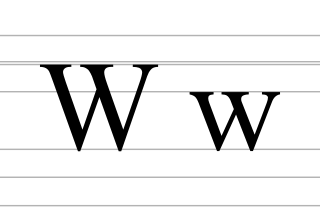
W, or w, is the twenty-third letter of the Latin alphabet, used in the modern English alphabet, the alphabets of other western European languages and others worldwide. Its name in English is double-u, plural double-ues.
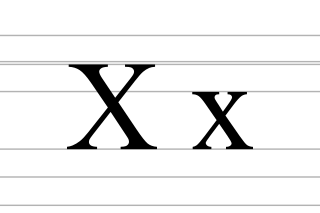
X, or x, is the twenty-fourth letter of the Latin alphabet, used in the modern English alphabet, the alphabets of other western European languages and others worldwide. Its name in English is ex, plural exes.

Z, or z, is the twenty-sixth and last letter of the Latin alphabet, used in the modern English alphabet, the alphabets of other western European languages and others worldwide. Its usual names in English are zed, which is most commonly used in international English and zee, only used in American, sometimes Canadian and Caribbean English and with an occasional archaic variant izzard.
Finnish orthography is based on the Latin script, and uses an alphabet derived from the Swedish alphabet, officially comprising twenty-nine letters but also including two additional letters found in some loanwords. The Finnish orthography strives to represent all morphemes phonologically and, roughly speaking, the sound value of each letter tends to correspond with its value in the International Phonetic Alphabet (IPA) – although some discrepancies do exist.
A caron is a diacritic mark commonly placed over certain letters in the orthography of some languages to indicate a change of the related letter's pronunciation.

Ll/ll is a digraph that occurs in several languages.

A digraph or digram is a pair of characters used in the orthography of a language to write either a single phoneme, or a sequence of phonemes that does not correspond to the normal values of the two characters combined.
Italian orthography uses 21 letters of the 26-letter Latin alphabet to write the Italian language. This article focuses on the writing of Standard Italian, based historically on the Florentine dialect, and not the other Italian dialects.

Che, Cha or Chu is a letter of the Cyrillic script.
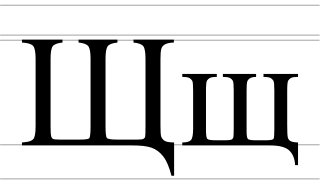
Shcha, Shta, Scha, Šče or Sha with descender is a letter of the Cyrillic script. In Russian, it represents the long voiceless alveolo-palatal fricative, similar to the pronunciation of ⟨sh⟩ in Welsh-sheep. In Ukrainian and Rusyn, it represents the consonant cluster, something like cash-chest. In Bulgarian, it represents the consonant cluster. Most other non-Slavic languages written in Cyrillic use this letter to spell the few loanwords that use it or foreign names; it is usually pronounced, an approximation of the Russian pronunciation of the letter, and is often omitted when teaching those languages.

Ch is a digraph in the Latin script. It is treated as a letter of its own in the Chamorro, Old Spanish, Czech, Slovak, Igbo, Uzbek, Quechua, Ladino, Guarani, Welsh, Cornish, Breton, Ukrainian, Japanese, Latynka, and Belarusian Łacinka alphabets. Formerly ch was also considered a separate letter for collation purposes in Modern Spanish, Vietnamese, and sometimes in Polish; now the digraph ch in these languages continues to be used, but it is considered as a sequence of letters and sorted as such.

Sz is a digraph of the Latin script, used in Polish, Kashubian and Hungarian, and in the Wade–Giles system of Romanization of Chinese, as well as the Hong Kong official romanization of Cantonese.
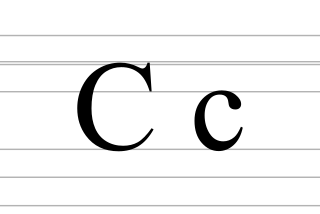
C, or c, is the third letter of the Latin alphabet, used in the modern English alphabet, the alphabets of other western European languages and others worldwide. Its name in English is cee, plural cees.

Portuguese orthography is based on the Latin alphabet and makes use of the acute accent, the circumflex accent, the grave accent, the tilde, and the cedilla to denote stress, vowel height, nasalization, and other sound changes. The diaeresis was abolished by the last Orthography Agreement. Accented letters and digraphs are not counted as separate characters for collation purposes.
Nh is a digraph of the Latin alphabet, a combination of N and H. Together with lh and the interpunct, it is a typical feature of Occitan, a language illustrated by medieval troubadours. It commonly represents the voiced palatal nasal [ɲ], which is the same sound as the Spanish letter Ñ.